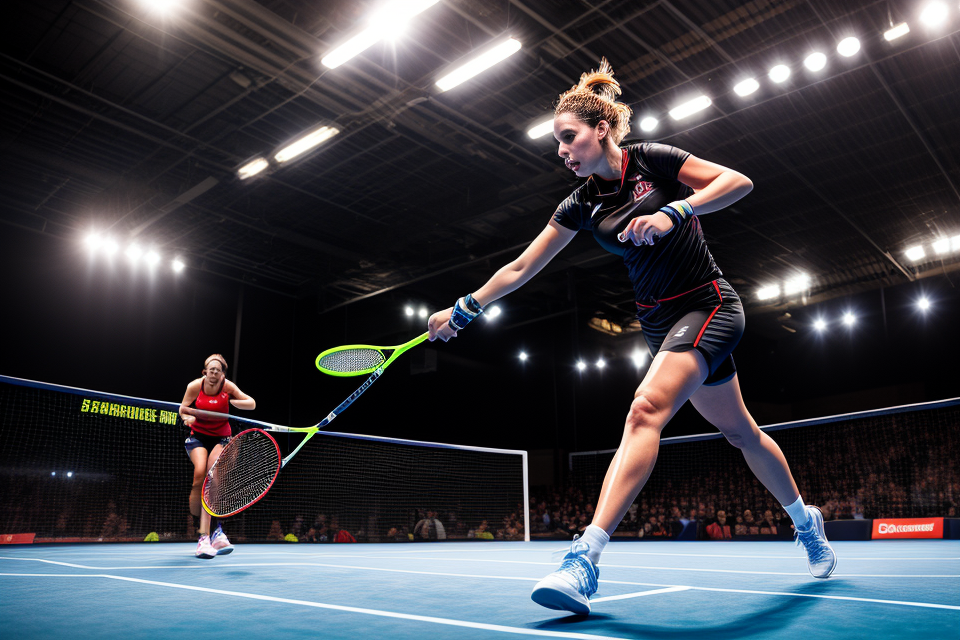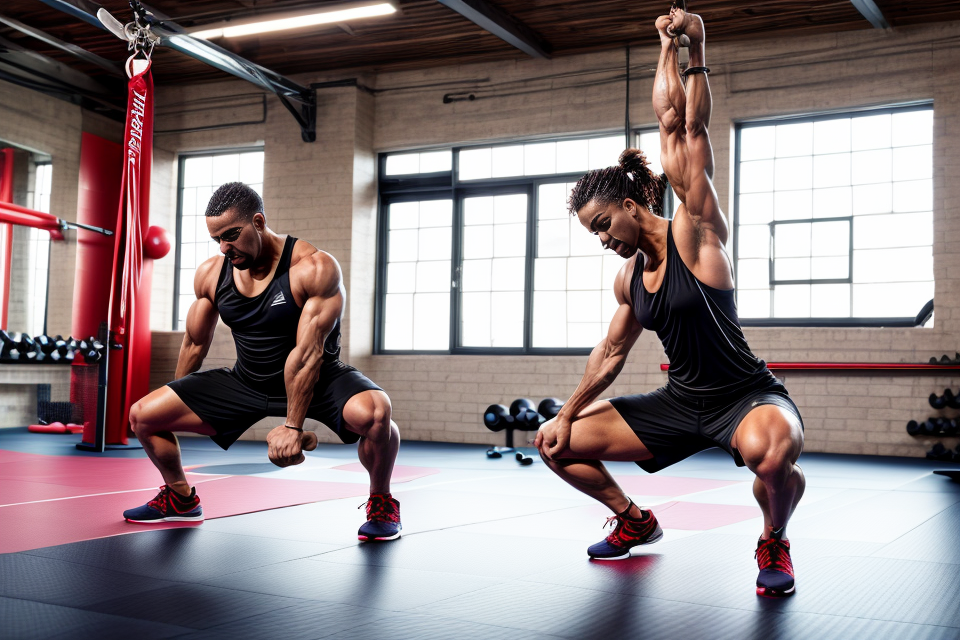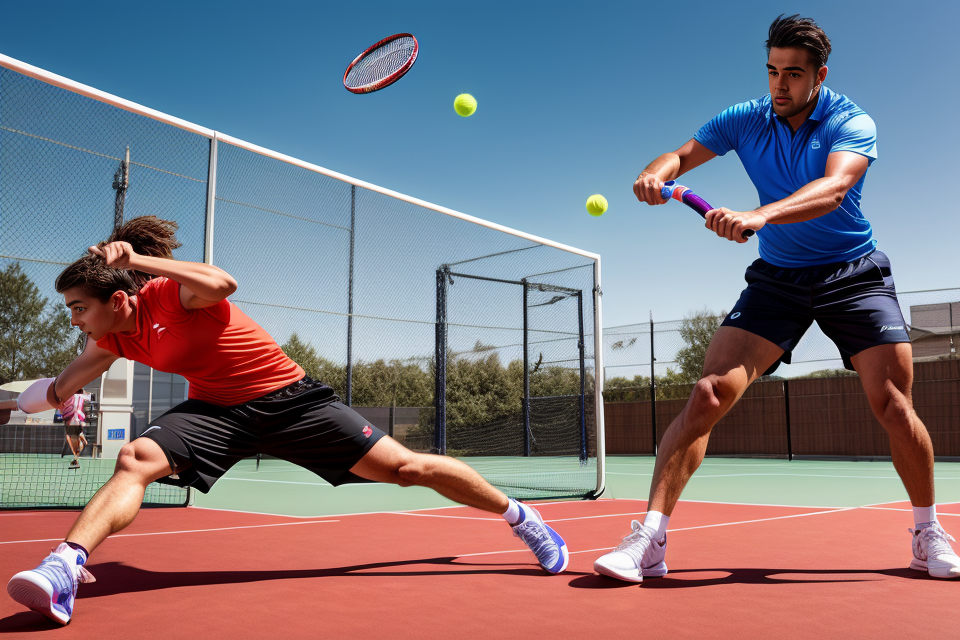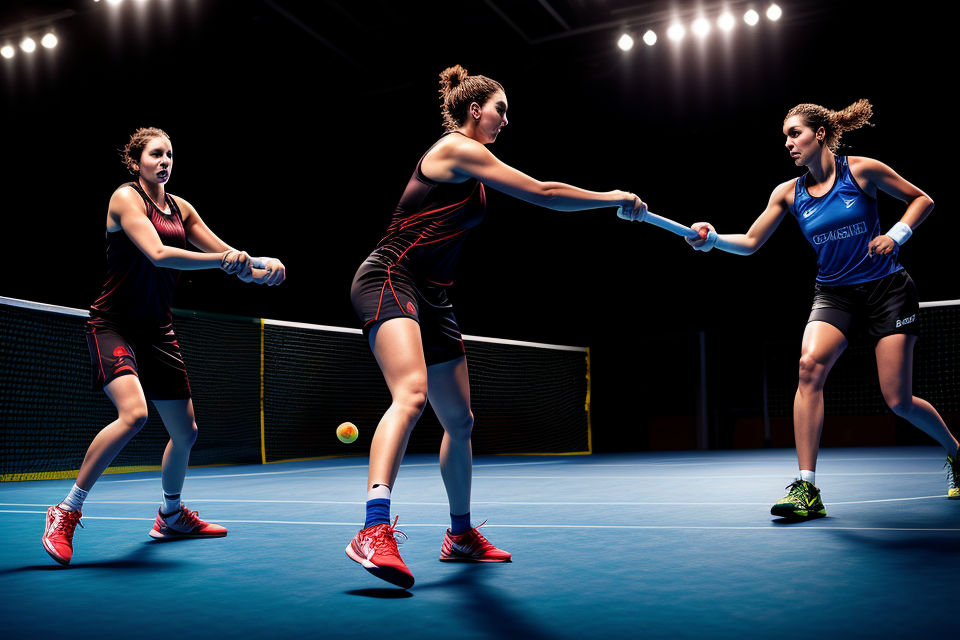Are you looking to take your squash game to the next level? Then it’s time to focus on improving your speed! Speed is a crucial aspect of squash, as it allows you to move quickly around the court, get to the ball in time, and execute shots with precision. In this article, we’ll explore some tips and techniques for improving your speed in squash, so you can dominate the competition. Whether you’re a beginner or an experienced player, these strategies will help you enhance your speed and agility on the court. Get ready to take your squash game to new heights!
To improve your speed in squash, it’s important to focus on a combination of strength and conditioning exercises, as well as drills that target specific aspects of the game such as footwork and agility. Additionally, practicing proper technique and form during matches can help you move more efficiently and effectively on the court. Incorporating plyometric exercises, which are designed to improve power and explosiveness, can also be beneficial. It’s also important to make sure you’re properly warming up and cooling down before and after matches to prevent injury and improve overall performance. Lastly, it’s essential to maintain a healthy diet and get enough rest to support your physical fitness and recovery.
Understanding Speed in Squash
Importance of Speed in Squash
Speed is a crucial aspect of the game of squash, and it plays a vital role in determining the outcome of a match. Speed refers to the ability to move quickly and efficiently around the court, and it encompasses both physical speed and mental speed.
In squash, speed is important for several reasons. Firstly, it allows players to get to the ball faster and make more shots. Secondly, it enables players to recover quickly from shots played by their opponents. Thirdly, it helps players to move into position for the next shot, giving them an advantage over their opponent.
Having good speed in squash offers several advantages. It allows players to control the pace of the game, and it helps them to tire out their opponents more quickly. Additionally, players with good speed are better able to recover from lost points and maintain their focus throughout the match.
In conclusion, speed is a critical aspect of the game of squash, and it is essential for players to work on improving their speed in order to improve their overall performance on the court.
Components of Speed in Squash
Speed in squash is a crucial aspect that determines a player’s ability to move around the court quickly and efficiently. There are several components that contribute to speed in squash, including physical, mental, and technical factors.
Physical Factors Affecting Speed in Squash
The physical factors that affect speed in squash include:
- Strength and power: A player’s strength and power are crucial in generating speed on the court. This involves having strong legs, core, and upper body, which allow for explosive movements and quick changes of direction.
- Flexibility and mobility: Flexibility and mobility are important for squash players as they enable them to move freely and efficiently around the court. This includes having good range of motion in the hips, knees, and ankles, which allows for smooth and fluid movements.
- Cardiovascular endurance: Cardiovascular endurance is important for maintaining high intensity throughout a match. This involves having a strong heart and lung system, which allows for efficient delivery of oxygen and nutrients to the muscles.
Mental Factors Affecting Speed in Squash
The mental factors that affect speed in squash include:
- Concentration: Concentration is important for staying focused on the game and making quick decisions on the court. This involves being able to block out distractions and stay fully engaged in the match.
- Confidence: Confidence is important for playing at a high level and pushing oneself to the limit. This involves having a positive mindset and believing in one’s abilities to perform at a high level.
- Mental toughness: Mental toughness is important for dealing with adversity and bouncing back from setbacks. This involves having a resilient mindset and being able to stay calm and focused under pressure.
Technical Factors Affecting Speed in Squash
The technical factors that affect speed in squash include:
- Footwork: Footwork is a crucial aspect of squash that involves moving efficiently and effectively around the court. This includes having good balance, coordination, and timing, which allows for smooth and precise movements.
- Stroke mechanics: Stroke mechanics are important for generating power and speed on the court. This involves having a consistent and efficient stroke technique, which allows for maximum speed and accuracy.
- Equipment: Equipment such as rackets and shoes can also affect speed in squash. This includes having the right equipment that is well-suited to one’s playing style and allows for maximum speed and performance.
Warm-up and Stretching Exercises
Purpose of Warm-up and Stretching Exercises
- Importance of warming up before exercise
- Increases blood flow to muscles
- Prepares muscles for physical activity
- Reduces risk of injury
- Importance of stretching exercises
- Increases flexibility and range of motion
- Improves muscle elasticity
- Prevents muscle soreness and stiffness
In order to improve your speed in squash, it is important to start with a proper warm-up and stretching exercises. Warming up before exercise is crucial as it increases blood flow to the muscles, prepares them for physical activity, and reduces the risk of injury. It is recommended to engage in light cardiovascular exercises such as jogging or cycling for five to ten minutes before starting your squash practice.
Stretching exercises are also essential to improve your speed in squash. Stretching helps to increase flexibility and range of motion, improves muscle elasticity, and prevents muscle soreness and stiffness. It is recommended to focus on stretching the major muscle groups used in squash, such as the legs, hips, and upper body. Dynamic stretching, which involves moving while stretching, is more effective than static stretching, which involves holding a stretch for a prolonged period of time.
It is important to note that the warm-up and stretching exercises should be tailored to your individual needs and level of fitness. If you have any underlying medical conditions or injuries, it is best to consult with a medical professional before starting any new exercise routine. Additionally, it is important to incorporate these exercises into your regular practice and make them a part of your pre-game routine to ensure optimal performance on the court.
Warm-up Exercises for Squash
As a player, warming up before a game of squash is crucial to preparing your body for the physical demands of the sport. A proper warm-up routine should include a combination of dynamic stretching exercises, aerobic exercises, and strength exercises.
Dynamic stretching exercises involve movements that gradually increase your range of motion and blood flow to your muscles. These exercises are especially important for squash players because they help to improve your agility, balance, and coordination on the court. Some examples of dynamic stretching exercises include leg swings, arm circles, and high knees.
Aerobic exercises are also important for squash players because they help to improve your cardiovascular endurance, which is essential for playing the sport at a high level. Some examples of aerobic exercises include jogging, cycling, and jumping jacks.
Strength exercises are important for building the muscular strength and endurance needed to play squash at a high level. Some examples of strength exercises include lunges, squats, and push-ups. It is important to include both upper and lower body strength exercises in your warm-up routine to ensure that all of the muscles used in squash are properly prepared for the game.
Overall, a well-rounded warm-up routine that includes dynamic stretching, aerobic exercises, and strength exercises is essential for improving your speed and performance on the squash court.
Stretching Exercises for Squash
As a crucial aspect of improving one’s performance in squash, stretching exercises are highly recommended. These exercises can help increase flexibility, improve balance, and reduce the risk of injury. In this section, we will discuss various stretching exercises that can be beneficial for squash players.
Flexibility Exercises
Flexibility exercises are designed to improve the range of motion of the joints and muscles. By incorporating these exercises into your warm-up routine, you can improve your overall flexibility and reduce the risk of injury. Here are some examples of flexibility exercises that can be beneficial for squash players:
- Hamstring stretches: These stretches can help improve the flexibility of the hamstrings, which are important for explosiveness and power in squash.
- Calf stretches: Tight calf muscles can lead to injury, so it’s important to stretch them regularly. Calf stretches can also improve mobility and balance on the court.
- Triceps stretches: The triceps muscles are important for upper body power and strength in squash. Incorporating triceps stretches into your routine can help improve your overall arm strength and reduce the risk of injury.
Static Stretching Exercises
Static stretching exercises involve holding a stretch for a period of time to improve flexibility. These exercises can be done both before and after a squash match or practice. Here are some examples of static stretching exercises that can be beneficial for squash players:
- Butterfly stretch: This stretch targets the hips and thighs, which are important for movement and power on the court.
- Seated forward fold: This stretch can help improve flexibility in the lower back and hamstrings, which can lead to better posture and balance on the court.
- Shoulder stretch: Tight shoulders can lead to injury and limit mobility on the court. Incorporating shoulder stretches into your routine can help improve your overall shoulder mobility and reduce the risk of injury.
Yoga Exercises
Yoga is a great way to improve flexibility, balance, and core strength, all of which are important for squash players. Here are some examples of yoga exercises that can be beneficial for squash players:
- Downward dog: This pose can help improve flexibility in the hamstrings, hips, and spine, which can lead to better posture and balance on the court.
- Warrior II: This pose can help improve balance and stability, which are important for moving quickly and powerfully on the court.
- Plank pose: This pose can help improve core strength, which is important for maintaining proper form and reducing the risk of injury.
By incorporating these stretching exercises into your warm-up routine, you can improve your overall flexibility, balance, and strength, which can lead to better performance on the squash court.
Drills to Improve Speed in Squash
Footwork Drills
- Forward and backward movements
- Running drills
- Forward and backward running
- High knees
- Butt kicks
- Shuffle drills
- Forward and backward shuffle
- Lateral shuffle
- Agility drills
- Cutting and planting
- Changing direction
- Running drills
- Side-to-side movements
- Box jumps
- Lateral bounds
- Quick feet drill
- Multi-directional movements
- Drill that incorporates all directions
- Agility ladder drills
- Slalom drills
Agility Drills
Improving your speed in squash requires a combination of strength, endurance, and agility. Agility drills are specifically designed to enhance your ability to move quickly and change direction with precision. These drills help improve your footwork, balance, and coordination, which are essential skills for success on the squash court.
Ladder Drills
Ladder drills are a classic agility exercise that involves running up and down a ladder placed on the court. To perform ladder drills, start at one end of the ladder and run up one ladder, then down the next ladder, alternating sides until you reach the end of the ladder. This drill helps improve your footwork, coordination, and reaction time.
Shuttle Runs
Shuttle runs are another agility drill that involves running back and forth between two points on the court. To perform shuttle runs, start at one end of the court and sprint to the other end. Then, turn around and sprint back to the starting point. Repeat this pattern for a set number of repetitions or for a specific amount of time. This drill helps improve your speed, endurance, and ability to change direction quickly.
Cone Drills
Cone drills are a versatile agility exercise that can be modified to suit different skill levels and focus areas. To perform cone drills, set up a series of cones on the court in a zig-zag pattern. Then, sprint from one cone to the next, weaving in and out of the cones as quickly as possible. This drill helps improve your footwork, balance, and ability to change direction at high speeds.
By incorporating these agility drills into your training routine, you can improve your speed and agility on the squash court. Remember to start with a few repetitions and gradually increase the intensity and duration of the drills as you progress. With consistent practice and dedication, you can enhance your speed and performance in squash.
Reaction and Movement Drills
Reaction and movement drills are crucial for improving speed in squash. These drills help to enhance reflexes, agility, and overall movement on the court. Some effective reaction and movement drills include:
- Reflex and Reaction Drills: These drills are designed to improve your reaction time and ability to respond quickly to incoming balls. Some examples include:
- Footwork drills, such as shuffling side to side or moving forward and backward, with a ball thrown randomly in different directions.
- Catching drills, where a ball is thrown to you and you must catch it with different parts of your body, such as your hands, arms, or legs.
- Agility and Movement Drills: These drills focus on improving your footwork and agility on the court. Some examples include:
- Ladder drills, where you run up and down a ladder placed on the court, improving your lateral movement and quick changes of direction.
- Cones drills, where you weave in and out of cones placed on the court, improving your agility and ability to move quickly and accurately.
- Jumping and Landing Drills: These drills are designed to improve your jumping ability and landing technique, which can help you move quickly and efficiently on the court. Some examples include:
- Box jumps, where you jump up onto a box or bench and then land softly on the ground.
- Single-leg jumps, where you jump on one leg and then land on the same leg, improving your balance and stability.
Overall, reaction and movement drills are essential for improving speed in squash. By practicing these drills regularly, you can enhance your reflexes, agility, and overall movement on the court, giving you a competitive edge over your opponents.
Plyometric Exercises
Plyometric exercises are a type of training that involves explosive movements designed to improve power, speed, and agility. These exercises are particularly effective for improving speed in squash because they target the muscles used in rapid direction changes and movements on the court. Here are some examples of plyometric exercises that can help improve speed in squash:
- Box jumps: Box jumps are a classic plyometric exercise that involves jumping up onto a box from a standing position. To perform a box jump, start with your feet shoulder-width apart and your knees slightly bent. Explosively jump up onto the box, landing with both feet on the surface and your hips aligned with your knees. Repeat for the desired number of repetitions.
- Squat jumps: Squat jumps are another plyometric exercise that involves jumping up from a squat position. To perform a squat jump, start by standing with your feet shoulder-width apart. Squat down by bending your knees and lowering your hips towards the ground. When you’re in a squat position, explosively jump up, reaching your hands towards the ceiling and landing softly on the balls of your feet. Repeat for the desired number of repetitions.
- Bounding exercises: Bounding exercises involve quick, rhythmic steps that help improve footwork and agility on the court. To perform a bounding exercise, start by taking a large step forward with one foot. Land on the ball of your foot and immediately push off with the same foot, taking a bounding step forward. Continue alternating legs and bounding forward for the desired distance or time.
Incorporating plyometric exercises into your training routine can help improve your speed and power on the squash court. However, it’s important to start with lighter weights and progress gradually to avoid injury. Additionally, be sure to incorporate proper form and technique into your exercises to ensure that you’re targeting the correct muscles and maximizing your results.
Nutrition and Recovery
Importance of Proper Nutrition
Proper nutrition is a crucial aspect of improving speed in squash. It plays a vital role in providing the body with the necessary nutrients required for energy production, muscle recovery, and overall performance enhancement.
Here are some key nutrients that are essential for improving speed in squash:
Carbohydrates
Carbohydrates are the primary source of energy for the body. They are stored in the muscles and liver and are used to fuel high-intensity physical activities such as squash. Consuming adequate amounts of carbohydrates can help improve endurance, reduce fatigue, and enhance performance.
Protein
Protein is essential for muscle growth and repair. It helps in building and repairing muscle tissue, which is crucial for improving speed and power in squash. Protein also helps in maintaining muscle mass and reducing muscle breakdown during intense physical activity.
Hydration
Staying hydrated is critical for optimal performance in squash. Dehydration can lead to fatigue, muscle cramps, and heat stroke, which can significantly impact your speed and performance on the court. It is essential to consume enough fluids before, during, and after physical activity to maintain proper hydration levels.
In addition to these key nutrients, it is also important to consume a balanced diet that includes a variety of fruits, vegetables, whole grains, and lean protein sources. Eating a well-balanced diet can help ensure that your body is receiving all the necessary nutrients required for optimal performance in squash.
Furthermore, it is recommended to consult with a registered dietitian or nutritionist to develop a personalized nutrition plan that suits your individual needs and goals. They can help you determine the appropriate amount of calories, macronutrients, and micronutrients required to support your training and performance in squash.
Recovery Techniques
- Rest and recovery time
- It is essential to allow the body time to recover after intense physical activity. Rest and recovery time allows the muscles to repair and rebuild, which can help to improve speed and performance in squash.
- It is recommended to take at least one rest day per week, and to also incorporate light physical activity on non-rest days to promote recovery.
- Massage therapy
- Massage therapy can help to improve circulation, reduce muscle tension, and promote relaxation. These benefits can help to improve speed and performance in squash by increasing blood flow to the muscles and allowing for better movement and flexibility.
- It is recommended to receive massage therapy from a licensed professional on a regular basis, especially after intense physical activity.
- Foam rolling
- Foam rolling is a self-massage technique that involves using a foam roller to apply pressure to tight or sore muscles. This technique can help to release tension in the muscles, improve circulation, and promote relaxation.
- Foam rolling can be done on a regular basis, especially after intense physical activity, to help improve speed and performance in squash. It is recommended to start with a light pressure and gradually increase as tolerated.
Mental Aspects of Speed in Squash
Mental Preparation
Visualization Techniques
Visualization techniques are an effective way to improve your speed in squash. This involves mentally rehearsing the actions and movements needed to perform at your best on the court. By visualizing yourself making quick and efficient movements, you can improve your muscle memory and increase your confidence on the court. It’s important to make the visualizations as vivid as possible, using all of your senses to imagine yourself playing the game.
Goal Setting
Setting specific and achievable goals can help you focus your mental preparation and improve your speed in squash. Your goals should be specific, measurable, attainable, relevant, and time-bound (SMART). For example, a goal could be to improve your footwork and movement on the court, or to increase your speed and agility through interval training. Having clear goals can help you stay motivated and focused on improving your speed and overall performance.
Self-Talk
The way you talk to yourself can have a big impact on your mental preparation and speed in squash. Negative self-talk can hold you back and reduce your confidence on the court, while positive self-talk can boost your motivation and help you perform at your best. It’s important to use positive and supportive language when talking to yourself, and to focus on your strengths and accomplishments rather than your weaknesses or mistakes. By using positive self-talk, you can build your confidence and improve your speed and performance on the court.
Managing Stress and Anxiety
Managing stress and anxiety is an essential part of improving your speed in squash. When you are feeling stressed or anxious, it can affect your focus, decision-making, and overall performance on the court. Here are some strategies that can help you manage stress and anxiety during a game:
Breathing Exercises
Breathing exercises are a simple yet effective way to calm your mind and body. Take slow, deep breaths and focus on your breath as you inhale and exhale. This can help slow down your heart rate, reduce tension in your muscles, and clear your mind. Try to take a few deep breaths before starting a game or when you feel yourself getting anxious during a game.
Relaxation Techniques
Relaxation techniques can help you release physical tension and reduce stress levels. Progressive muscle relaxation involves tensing and then relaxing different muscle groups in your body. Visualization techniques involve creating mental images of a relaxing scene or experience. These techniques can help you feel more relaxed and focused on the court.
Mindfulness Practices
Mindfulness practices involve paying attention to the present moment without judgment. This can help you stay focused on the game and avoid getting caught up in negative thoughts or worries. Mindfulness practices include meditation, yoga, and deep breathing exercises. Try incorporating mindfulness practices into your pre-game routine or take a few moments during a game to focus on your breath and the present moment.
Focus and Concentration
Maintaining focus during matches
One of the most critical aspects of improving speed in squash is maintaining focus during matches. This involves staying mentally alert and attentive to the game at all times, which can be challenging, especially when the game is fast-paced and demanding.
To maintain focus during matches, it is essential to have a clear mental state and avoid distractions. This can be achieved by developing a pre-match routine that helps you to mentally prepare for the game, such as visualizing your game plan or focusing on your breathing.
Additionally, it is crucial to stay hydrated and maintain a healthy diet to ensure that your mind remains sharp and focused throughout the match.
Avoiding distractions
Avoiding distractions is also critical to maintaining focus during matches. Distractions can come in many forms, such as noise from the crowd, the sound of other players, or even your own thoughts.
To avoid distractions, it is essential to develop a pre-match routine that helps you to mentally prepare for the game, such as visualizing your game plan or focusing on your breathing. Additionally, it is crucial to stay hydrated and maintain a healthy diet to ensure that your mind remains sharp and focused throughout the match.
Building mental toughness
Building mental toughness is also crucial to improving speed in squash. Mental toughness refers to the ability to remain focused and determined, even in the face of adversity or setbacks.
To build mental toughness, it is essential to develop a positive mindset and learn to manage your emotions effectively. This can be achieved by practicing mindfulness techniques, such as deep breathing or visualization, or by working with a sports psychologist to develop a personalized mental training program.
Additionally, it is crucial to learn from your mistakes and failures, rather than dwelling on them, and to maintain a positive attitude, even when things are not going well. By building mental toughness, you can improve your ability to maintain focus and concentration during matches, which can help you to improve your speed and overall performance in squash.
Injury Prevention and Safety
Injury Prevention Techniques
Improving speed in squash requires not only physical training but also injury prevention techniques to ensure that you can avoid injuries and maintain your performance level. Here are some techniques to consider:
- Proper equipment: Wearing the right equipment is essential to prevent injuries. Make sure to wear proper squash shoes that provide good support and traction on the court. Additionally, wearing protective gear such as a mouthguard, wrist guards, and eye protection can help prevent injuries to the face and hands.
- Proper technique: Developing proper technique is crucial to prevent injuries. Ensure that you have proper form and technique when hitting the ball, jumping, and changing direction. Take the time to learn and practice proper technique from a qualified coach or instructor.
- Gradual progression: Increasing your speed and intensity too quickly can lead to injuries. Gradually increase your speed and intensity over time to allow your body to adapt and avoid injuries. Start with shorter sessions and gradually increase the duration and intensity of your workouts. Additionally, make sure to take breaks between sessions to allow your body to recover.
By incorporating these injury prevention techniques into your training routine, you can reduce the risk of injuries and improve your speed in squash.
Safety Measures
Warm-up and cool-down exercises
Prior to beginning any physical activity, it is important to engage in a proper warm-up routine. This can include light cardiovascular exercise, such as jogging or cycling, to increase blood flow and raise your heart rate. Dynamic stretching, which involves active movements to increase range of motion, is also beneficial before squash matches. Following your match, a cool-down routine should be completed to gradually decrease your heart rate and stretch your muscles to prevent stiffness and soreness.
Stretching exercises
Stretching is a crucial component of injury prevention in squash. Prior to starting your match, static stretching exercises, such as holding a stretch for 15-30 seconds, can help to increase flexibility and reduce the risk of injury. Additionally, static stretching after your match can help to improve recovery time and reduce muscle soreness.
Avoiding overuse injuries
Overuse injuries, such as tendonitis or stress fractures, can be prevented by implementing proper training techniques and avoiding excessive repetition of movements. Varying your training routine and incorporating strength training exercises can help to build overall muscle strength and reduce the risk of injury. Additionally, it is important to listen to your body and take breaks when necessary to prevent overuse and fatigue.
Ergonomics and Equipment
One of the key factors in improving speed in squash is ensuring proper ergonomics and equipment. This includes:
- Proper grip and hold of the racket: A correct grip on the racket is essential for generating power and control during shots. The palm should be facing towards the sky and the fingers should be wrapped around the handle. It is important to keep the racket in a neutral position and avoid overextending the wrists.
- Proper footwear: Squash is a fast-paced sport that requires quick movements in all directions. Good footwear can help reduce the risk of injury and improve performance. It is important to choose shoes that provide adequate support and cushioning, as well as a good grip on the court surface.
- Proper eyewear: Squash can be a high-impact sport that involves rapid changes in direction and speed. Proper eyewear can help protect the eyes from impact and debris, as well as reduce glare and improve visibility on the court. It is important to choose eyewear that fits comfortably and does not obstruct vision.
FAQs
1. What are the key elements of speed in squash?
The key elements of speed in squash include footwork, agility, reaction time, and explosiveness. These elements all work together to help you move quickly and efficiently around the court, allowing you to get to balls that would otherwise be out of reach and to put pressure on your opponent.
2. How can I improve my footwork in squash?
Improving your footwork in squash involves practicing a variety of movements, including direction changes, jumps, and turns. You should also focus on maintaining good body position and balance, as this will help you move more quickly and efficiently. Additionally, practicing drills that involve moving to different parts of the court can help you improve your footwork and overall speed.
3. How can I improve my agility in squash?
Improving your agility in squash involves practicing quick changes of direction and movement patterns. You can do this by practicing drills that involve moving to different parts of the court and making sudden changes in direction. Additionally, focusing on improving your balance and body control can help you move more quickly and efficiently around the court.
4. How can I improve my reaction time in squash?
Improving your reaction time in squash involves practicing drills that involve quick movements and response times. You can also work on improving your visual tracking skills, which will help you see the ball more quickly and react to it more efficiently. Additionally, focusing on improving your overall fitness and physical conditioning can help you react more quickly to changing situations on the court.
5. How can I improve my explosiveness in squash?
Improving your explosiveness in squash involves practicing drills that involve quick movements and jumps. You can also work on improving your power and strength, which will help you make quick and powerful movements around the court. Additionally, focusing on improving your overall fitness and physical conditioning can help you improve your explosiveness and speed.










